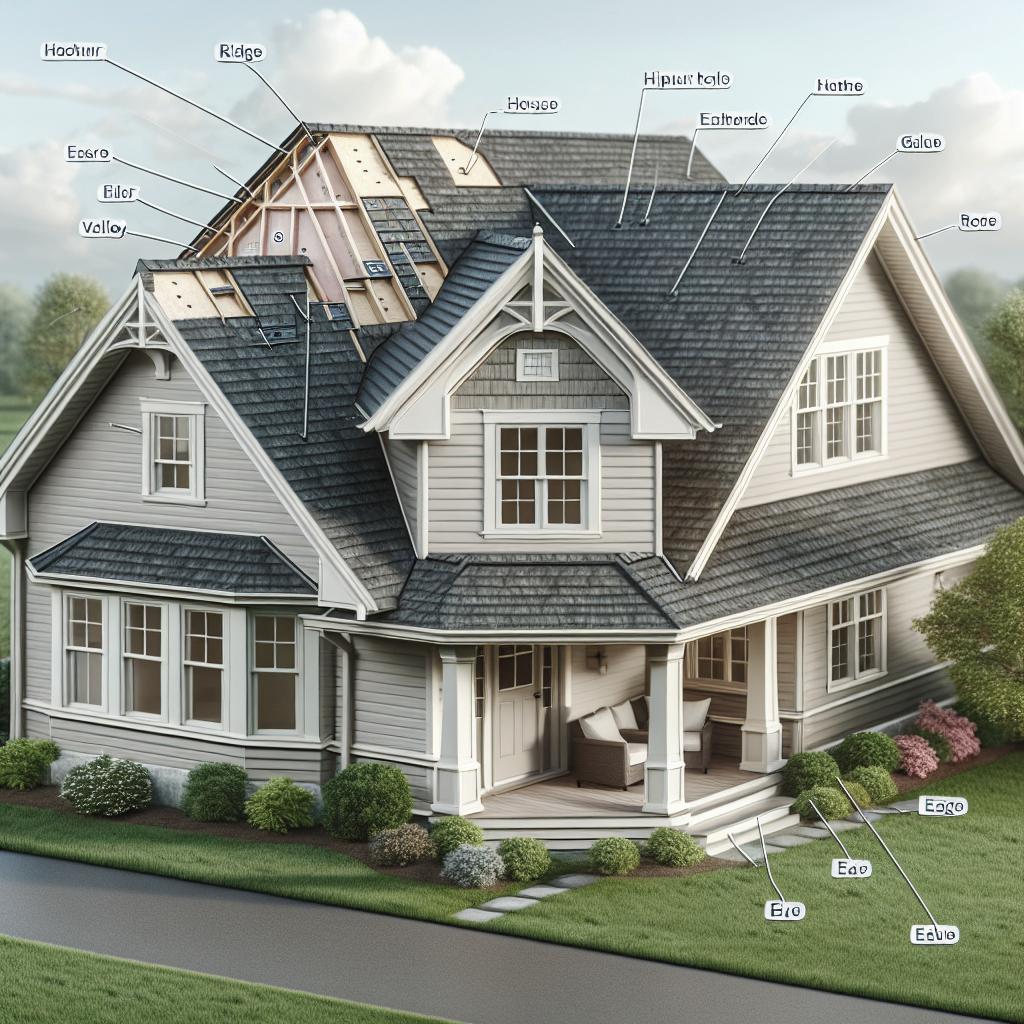Terminology of Roof Parts Explained
Understanding the complex terminology associated with roofing is invaluable whether you’re considering a roof replacement or simply aiming to become more knowledgeable about home maintenance. This guide will delve into each component of a roof, from foundational structures like roof decking and underlayment to more visible elements such as shingles and vents. We’ll explore how these components interact to provide protection and durability. By the end, you’ll have a comprehensive understanding of not just individual parts, but also how they contribute to the roof’s overall performance and aesthetics.
Roof Decking (Roof Sheathing)
The roof decking is a critical component of any roofing system. Also known as roof sheathing, it forms the base of your roof. Decking is typically made from plywood or oriented strand board (OSB) and is used to hold the other layers of the roof in place. Proper installation of the decking ensures structural integrity and prevents potential damage from external factors such as wind and rain.
Aside from providing structural support, the decking also affects the roof’s ability to breathe. Ventilation is crucial, and improper installation of decking can lead to moisture build-up which can deteriorate the material over time. When assessing your roof, it’s essential to evaluate the condition of the decking, especially if you plan on replacing your roofing material.
Drip Edge
A drip edge is a metal flashing installed along the edges of the roof. It plays a critical role in directing water away from the fascia and into the gutter. This not only protects your roof structure but also prevents water from seeping into areas that could cause rot and damage over time.
Drip edges are often overlooked but are necessary for maintaining the longevity of your roofing system. By ensuring that water is diverted away effectively, they help in reducing the risk of moisture infiltration, thereby safeguarding your home’s structure against potential leaks.
Ice and Water Shield
In climates prone to harsh winters, an ice and water shield is an invaluable addition to the roofing system. This protective underlayment is placed along the eaves and in valleys to prevent water from penetrating the roof during ice formation and melting cycles.
The shield is a self-adhering membrane that provides an additional barrier where water is likely to collect. This preventive measure is crucial in protecting your roof from ice dams and maintaining the overall integrity of your roofing during adverse weather conditions.
Roof Underlayment
Roof underlayment refers to the felt or synthetic material that is laid between the roof decking and the shingles. Its primary function is to provide a secondary layer of protection against water infiltration. Underlayments can be water-resistant or waterproof, depending on the material used.
The choice of underlayment can significantly influence the durability and performance of your roofing system. While traditional felt is still widely used, many homeowners are turning to synthetic options due to their enhanced durability and ease of installation.
Starter Shingles
Starter shingles are specifically designed to be the first row of shingles installed on your roof. They provide a clean edge for the rest of the shingles to line up with and are crucial for ensuring a seamless and effective installation.
By sealing the eaves and rakes, starter shingles help prevent wind and water from penetrating the roofing system. Investing in quality starter shingles is essential for maximizing the efficiency and lifespan of the entire roof.
The Type of Roofing Material You Choose
One of the most critical decisions in roofing is the choice of material. Options range from asphalt shingles and metal, to more unique materials like slate, tile, or wood shakes. Each has its own benefits and drawbacks in terms of cost, durability, and aesthetic potential.
It’s important to consider factors such as climate, architectural style, and personal preference when selecting roofing materials. Asphalt shingles are often chosen for their affordability and versatility, while materials like metal offer exceptional durability and energy efficiency.
Roof Flashing
Roof flashing is a vital component in preventing water infiltration at joints and seams in the roofing system. Typically made from metal, flashing is installed wherever the roof intersects with other structures such as chimneys, walls, and valleys.
Proper installation of roof flashing can significantly extend the life of your roof by preventing leaks and the damage they can cause. Regular inspection and maintenance of the flashing are essential, as even minor issues can lead to significant problems over time.
Ridge Capping
Ridge capping is the roofing material that covers the ridge line of the roof. It’s the finishing touch that enhances both the aesthetic appeal and weatherproofing of a roof. This component is crafted to fit over the seam of the roof and prevents rain and debris from entering.
Beyond aesthetics, ridge capping plays a crucial role in ensuring that your roof is wind-resistant and can handle severe weather conditions. It also provides an additional barrier against moisture infiltration at the most vulnerable part of the roof.
Roof Vents
Roof vents are installed to facilitate airflow and regulate temperature within the attic. Proper ventilation is crucial to ensure the longevity of your roof and the comfort of your living space. Inadequate ventilation can lead to heat buildup, moisture issues, and increased energy costs.
There are various types of roof vents, including ridge vents, soffit vents, and powered attic ventilators. Each serves a unique purpose, and their combined use ensures optimal roofing performance by managing airflow effectively.
More Roofing Terminology You Need to Know
Rakes and Eaves
The rake and eaves are two edges of the roof that project beyond the walls of a building. Eaves are the lower border of the roof that overhangs the wall, while the rake is the sloped edge of a gable roof. Both play vital roles in the roof’s drainage system and in protecting the house’s structural integrity.
Roof Facets
Facets of a roof refer to the various flat planes or surfaces that make up the roof structure. Understanding the number and shape of the facets is important for calculating roofing materials and labor costs, especially in complex roof designs.
Roof Valleys and Hips
Valleys are the internal angles formed by the intersection of two sloping roof planes. They are crucial in channeling rainwater off the roof. Hips, on the other hand, are the external angles or ridges where two roof planes meet.
Gable
A gable is the triangular portion of a wall between the edges of a sloped roof. It’s a common architectural feature that enhances the aesthetic appeal of a house and often incorporates windows to allow for ventilation and light.
Fascia
The fascia is a board that runs along the edge of the roof. It serves as a space to mount gutters and prevents water from getting into the roof. A well-maintained fascia also enhances the curb appeal of your house.
Soffit
The soffit is the underside of the roof overhang. It’s usually ventilated to help with airflow in the attic and provide a neat, finished appearance. Maintaining a well-ventilated soffit is essential for prolonging the roof’s lifespan.
Dormer
Dormers are vertical structures that project from a sloping roof, typically containing a window. They add architectural interest and are used to increase the usable space in a loft or attic by creating extra headroom and light.
What Do You Need to Know About a Roof Replacement?
Roof replacement is a significant home improvement project that requires careful planning and budgeting. Knowing the terminology and understanding the function of each roof component will better equip you to make informed decisions during the process.
Before committing to a roof replacement, consider the specifics of your existing roof, the material options available, and the professional expertise required. Often, homeowners overlook the details that can lead to unnecessary expenses and prolonged installation times.
Summary of Main Points
| Component | Function | Key Points |
|---|---|---|
| Roof Decking | Base support layer | Structural integrity, ventilation impact |
| Drip Edge | Water diversion | Protects fascia, prevents leaks |
| Ice and Water Shield | Barrier in vulnerable areas | Protects against ice dams |
| Roof Underlayment | Secondary water barrier | Traditional felt vs. synthetic options |
| Starter Shingles | Initial row for shingle alignment | Ensures wind resistance |
| Roofing Material | Primary covering | Varieties include asphalt, metal, slate |
| Roof Flashing | Prevents water entry at joints | Critical for leak prevention |
| Ridge Capping | Covers roof edge seams | Improves aesthetics, enhances protection |
| Roof Vents | Supports airflow | Reduces heat buildup, prevents moisture |
| Rakes and Eaves | Roof edge components | Drainage system support |
| Roof Valleys and Hips | Channels and ridges | Essential for water drainage |
| Gable | Triangular wall segment | Architectural significance |
| Fascia | Edge board | Supports gutters, enhances aesthetics |
| Soffit | Underside of overhang | Ventilation, aesthetic finish |
| Dormer | Roof window structure | Increases space and light |


